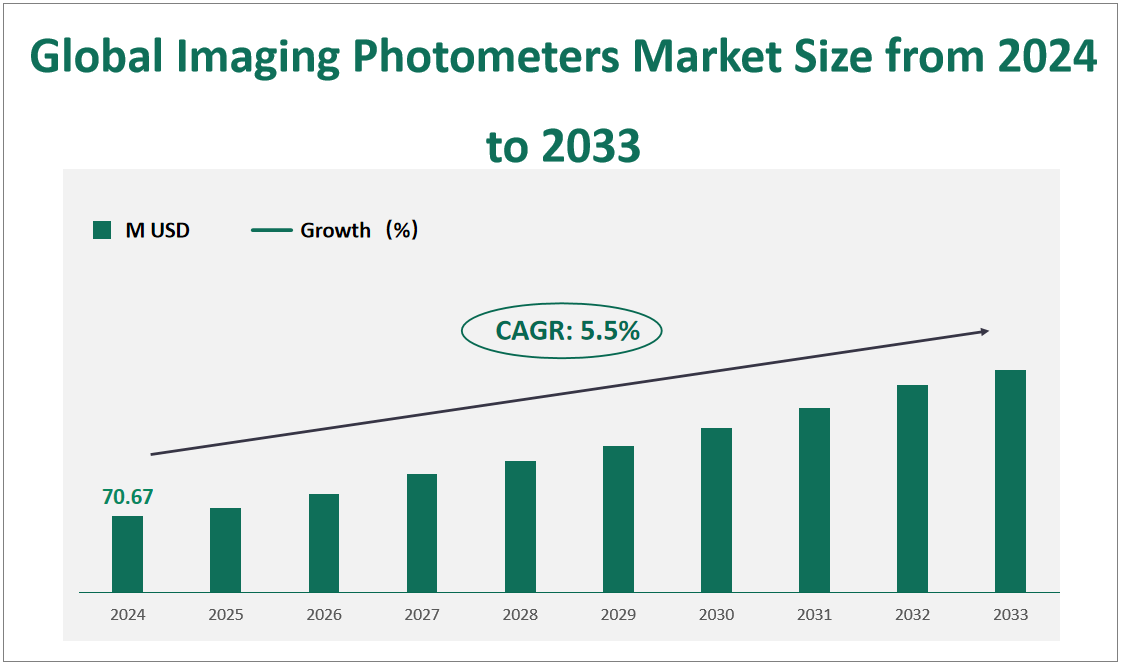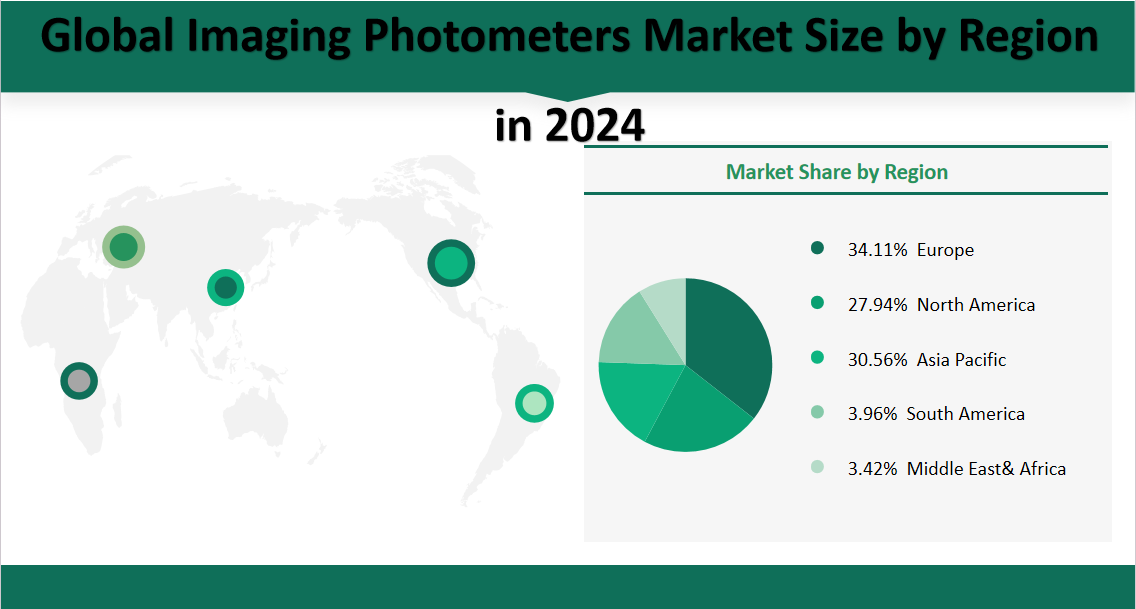1 Global Imaging Photometers Market Outlook
The global Imaging Photometers market is projected to exhibit substantial growth in the coming years, with a CAGR of 5.5% from 2024 to 2033, reaching a total market size of $70.67 million USD in 2024. Imaging photometers are sophisticated instruments that measure the illuminance, brightness, or color of millions of points simultaneously. These devices are based on CCD (Charge-Coupled Device) or CMOS (Complementary Metal-Oxide-Semiconductor) technology and are widely used in various applications, including display testing, light measurement, surface inspection, keyboard inspection, and automotive solutions. The ability to capture detailed photometric data makes imaging photometers essential for industries where precision and accuracy are critical.
The market is segmented based on technology types, such as Full Frame CCD, Interline Transfer CCD, and other variants. Full Frame CCDs are known for their superior dynamic range and low noise, making them suitable for high-precision applications. In contrast, Interline Transfer CCDs offer faster readout speeds and are widely used in applications requiring rapid data acquisition. The market dynamics are influenced by technological advancements, industry trends, and the evolving needs of downstream industries.
Figure Global Imaging Photometers Market Size and Growth Rate (2024-2033)

2 Imaging Photometers Market Growth Drivers and Constraints
The growth of the global Imaging Photometers market is influenced by several key drivers and constraints.
Market Drivers:
Increasing Demand from the Automotive Industry: The automotive sector is a significant driver of the imaging photometers market. With the development of advanced lighting systems and in-vehicle displays, the need for precise light measurement and inspection has increased. Imaging photometers are used to test the brightness, color, and uniformity of automotive lighting, ensuring compliance with safety and quality standards.
Growth in Consumer Electronics: The continuous evolution of consumer electronics, such as smartphones, tablets, and laptops, has led to a higher demand for imaging photometers. These devices are used to inspect display quality, ensuring uniform brightness and color accuracy. The rise of new technologies like OLED and microLED displays further fuels the need for advanced photometric testing.
Expansion of the Keyboard Market: The increasing demand for computer keyboards, driven by the growth of the internet and 5G technology, has created a need for high-volume inspection solutions. Imaging photometers are used to ensure the uniformity and quality of backlit keyboards, contributing to the overall market growth.
Market Constraints:
High Production Technology Requirements: The production of imaging photometers requires advanced technological capabilities, including high-resolution sensors and precise optical systems. This high level of technology demands continuous innovation and investment from manufacturers, which can be a barrier to entry for new players.
Economic Uncertainty: The global economy is still recovering from the impacts of the COVID-19 pandemic, and ongoing geopolitical issues, such as the Russia-Ukraine war, have introduced additional uncertainties. These factors can affect market demand and supply chains, potentially slowing market growth.
Regulatory and Compliance Challenges: The imaging photometers market operates in a highly regulated environment, particularly in industries like automotive and aerospace. Compliance with international standards and certifications can be complex and costly, limiting the market’s expansion.
3 Imaging Photometers Market Innovations and M&A Activities
The Imaging Photometers market is characterized by continuous technological innovation and strategic corporate activities.
Technological Innovation:
Advancements in CCD and CMOS Sensors: The development of more sensitive and higher-resolution CCD and CMOS sensors has significantly enhanced the capabilities of imaging photometers. These advancements allow for more precise measurements and faster data acquisition, making the devices more effective in various applications.
Integration of AI and Machine Learning: The integration of artificial intelligence (AI) and machine learning algorithms has improved the accuracy and efficiency of photometric measurements. These technologies enable automated defect detection and analysis, reducing the need for manual inspection and increasing productivity.
Miniaturization and Portability: There is a growing trend towards the miniaturization of imaging photometers, making them more portable and easier to use in various environments. This trend is particularly beneficial for field applications and on-site inspections.
Corporate Mergers and Acquisitions:
Strategic Acquisitions: Major players in the market have engaged in strategic acquisitions to expand their product portfolios and enhance their technological capabilities. For example, Konica Minolta’s acquisition of Radiant Vision Systems and Instrument Systems has significantly strengthened its position in the imaging photometers market.
Partnerships and Collaborations: Companies are also forming strategic partnerships to leverage each other’s strengths. These collaborations often focus on joint research and development, market expansion, and the sharing of resources and expertise.
Market Consolidation: The imaging photometers market is becoming increasingly consolidated, with a few major players dominating the industry. This consolidation is driven by the need for scale, technological expertise, and market reach, making it more challenging for smaller players to compete.
In conclusion, the global Imaging Photometers market is poised for steady growth, driven by increasing demand from key industries and continuous technological advancements. However, the market also faces challenges related to high production technology requirements and economic uncertainties. Companies that can effectively navigate these challenges and leverage strategic opportunities are likely to succeed in this dynamic and evolving market
4 Global Imaging Photometers Market Analysis by Type
In 2024, the global Imaging Photometers market is projected to reach a value of $70.67 million. The market value is distributed among different types of imaging photometers as follows: Full Frame CCD is expected to be valued at $20.35 million, accounting for 28.79% of the total market; Interline Transfer CCD will hold the largest share with $46.35 million, representing 65.59%; and other types will contribute $3.97 million, making up 5.62% of the market.
Table Global Imaging Photometers Market Size and Share by Type in 2024
Type | Market Size in 2024 (M USD) | Market Share in 2024 (%) |
|---|---|---|
Full Frame CCD | 20.35 | 28.79% |
Interline Transfer CCD | 46.35 | 65.59% |
Others | 3.97 | 5.5.2% |
5 Global Imaging Photometers Market Analysis by Application
In 2024, the global Imaging Photometers market is forecasted to reach a value of $70.67 million. The market value distribution by application is as follows:
Display Test: $10.42 million, accounting for 14.74% of the total market value.
Light Measurement: $37.67 million, representing 53.30% of the market value.
Surface Inspection: $6.65 million, making up 9.40% of the market.
Keyboard Inspection: $2.75 million, contributing 3.89% to the market.
Automotive Solutions: $13.19 million, accounting for 18.67% of the total market value.
These figures highlight the significant role of Light Measurement applications in driving the market value, with Automotive Solutions also contributing a notable share.
Table Global Imaging Photometers Market Size and Share by Application in 2024
Application | Market Size in 2024 (M USD) | Market Share in 2024 (%) |
|---|---|---|
Display Test | 10.42 | 14.74% |
Light Measurement | 37.67 | 53.30% |
Surface Inspection | 6.65 | 9.40% |
Keyboard Inspection | 2.75 | 3.89% |
Automotive Solutions | 12.52 | 18.67% |
6 Global Imaging Photometers Market Analysis by Region
In 2024, the global Imaging Photometers market is projected to reach a value of $70.67 million, according to Maia Research. The market value share by region is expected to be distributed as follows:
North America: $19.75 million, accounting for 27.94% of the total market value.
Europe: $24.11 million, representing 34.11% of the market value.
Asia Pacific: $21.60 million, making up 30.56% of the market.
South America: $2.82 million, contributing 3.99% to the market.
Middle East and Africa: $2.40 million, accounting for 3.40% of the total market value.
These figures highlight the significant roles of Europe and Asia Pacific in driving the global Imaging Photometers market, with both regions holding a substantial share of the overall market value.
Figure Global Imaging Photometers Market Share by Region in 2024

7 Top 3 Companies of Global Imaging Photometers Market
7.1 Konica Minolta
Company Introduction and Business Overview:
Konica Minolta is a Japanese multinational technology company founded in 1936. It is headquartered in Tokyo, Japan. The company is renowned for its expertise in developing high-precision spectrometers, complex systems, and software solutions for spectrophotometry. In 2012, Konica Minolta acquired Instrument Systems, a German manufacturer of high-precision spectrometers, and in 2015, it acquired Radiant Vision Systems. This strategic expansion has significantly enhanced its capabilities in the imaging photometers market.
Products Offered:
Konica Minolta offers a range of imaging photometers, including the ProMetric® Y series, which is designed for high-volume production testing of displays, keyboards, lighting products, and surfaces. These devices combine a scientific-grade image sensor with a photopic filter to capture light values that reflect human visual perception of brightness. Other notable products include the CS-150/CS-160 portable tristimulus colorimeters, which are used for measuring the chromaticity and luminance of various light sources.
Sales Revenue in the Latest Year:
Konica Minolta’s revenue from imaging photometers was approximately $33.12 million, making it one of the leading players in the market.
7.2 Everfine
Company Introduction and Business Overview:
Everfine, also known as Hangzhou Everfine Photo-E-Info Co., Ltd., is a leading provider of optoelectronic measurement instruments and calibration services. Founded in 2003 and headquartered in Hangzhou, China, Everfine specializes in LED and lighting measurement instruments. The company’s products are exported to the United States, Europe, Japan, and other developed regions. Everfine is recognized for its high-quality measurement solutions and is a preferred supplier for research institutions and laboratories worldwide.
Products Offered:
Everfine offers a wide range of products, including the CX-800C imaging color luminance meter, which is designed for measuring two-dimensional luminance and chromaticity. This device is particularly suitable for applications requiring high precision and low brightness measurement. Other products include the UVGI-200 for UV irradiance distribution testing, the GO-R5000 for spatial photometric distribution testing, and the PMS-2000 for high-precision spectral analysis. These products are widely used in industries such as lighting, automotive, and display manufacturing.
Sales Revenue in the Latest Year:
Everfine’s revenue from imaging photometers was approximately $6.07 million.
7.3 Novanta
Company Introduction and Business Overview:
Novanta is a trusted technology partner for medical and advanced industrial OEMs. Founded in 1968, the company is headquartered in the United States. Novanta specializes in photonics, vision, and precision motion technologies, providing mission-critical core components and subsystems for various industries. The company’s acquisition of Photo Research has significantly bolstered its position in the imaging photometers market.
Products Offered:
Novanta offers products such as the SpectraScan® PR-740, a portable spectroradiometer designed for precise light measurements from various sources, including display monitors, projectors, and reflective surfaces. The device is widely used in applications such as LED testing, digital cinema, and automotive display testing.
Sales Revenue in the Latest Year:
Novanta’s revenue from imaging photometers was approximately $4.52 million.

